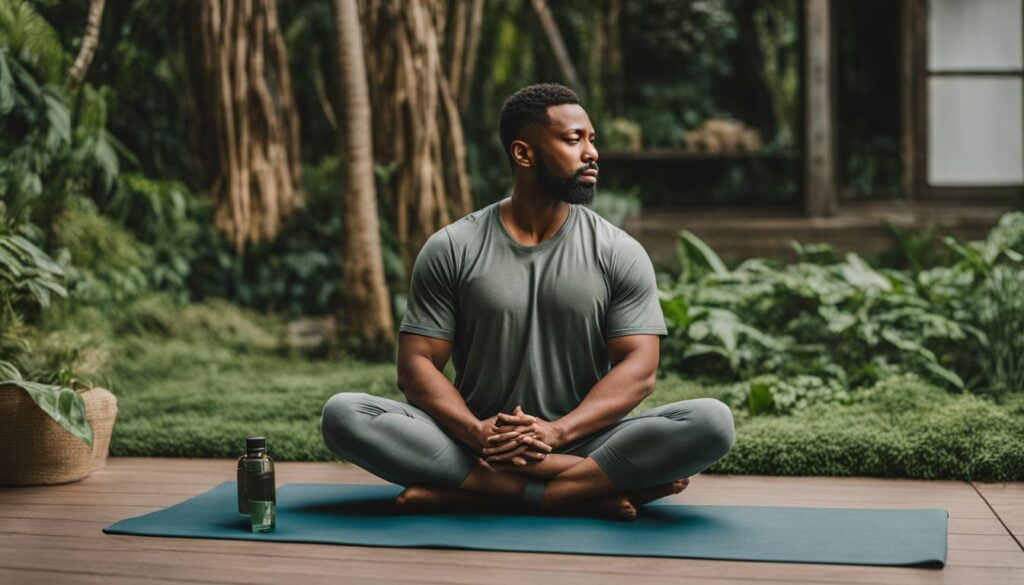Improve Your Stance: Yoga for Better Posture in Men
Yoga is an effective way to improve posture in men. Regular practice of yoga can help correct common postural issues such as forward head and rounded shoulders, which are often caused by poor lifestyle habits like sitting at a desk for long periods or using mobile phones excessively. Yoga improves posture by strengthening the postural muscles of the upper body and stretching tight shoulders and hamstrings. It can also relieve common aches and pains associated with poor posture, such as neck strains, lower back pain, and tension headaches. Any form of yoga can be beneficial, but Yin yoga or restorative yoga are especially recommended for improving posture. These styles work on the connective tissues, lengthening and realigning the body over time. Ashtanga yoga, a more challenging style that involves holding poses for longer periods, can also help improve posture. It is important to consult with an experienced yoga instructor, especially if you are new to yoga or have any injuries that may limit certain movements.
Helstu veitingar:
- Regular yoga practice can help correct postural issues in men.
- Yoga strengthens the postural muscles of the upper body and stretches tight shoulders and hamstrings.
- Yin yoga, restorative yoga, and Ashtanga yoga are recommended for improving posture.
- Consult with an experienced yoga instructor, especially if you are new to yoga or have specific limitations or injuries.
- Yoga can relieve common aches and pains associated with poor posture.
Can Yoga Improve Posture?
Yoga is a powerful practice that can help improve posture in men. By incorporating yoga exercises specifically targeted towards posture correction, individuals can see noticeable improvements in their alignment and overall posture over time. Yoga works by strengthening the postural muscles of the upper body, while also stretching tight areas such as the shoulders and hamstrings, which can contribute to better posture.
Regular yoga practice can correct common postural issues, such as forward head and rounded shoulders, which are often caused by poor lifestyle habits like sitting for long periods or excessive phone usage. While immediate results may not be seen, consistent and dedicated yoga practice can lead to significant improvements in posture.
It is important to approach yoga for posture improvement under the guidance of an experienced instructor. This is especially crucial for those who are new to yoga or have specific postural concerns or limitations. Consulting with a qualified instructor can help tailor a yoga routine that specifically targets posture correction and ensures safe and effective practice.
| Benefits of Yoga for Posture Improvement | Yoga Exercises for Posture Correction |
|---|---|
| Strengthens postural muscles |
|
| Stretches tight areas |
|
| Improves body alignment |
|
Incorporating yoga into your routine can be a transformative step towards addressing and correcting poor posture. By committing to a regular yoga practice, individuals can unlock strength, grace, and optimal posture. Remember, results may take time to manifest, but with dedication and consistency, the benefits of yoga for improved posture in men can be realized.
Best Yoga Poses for Better Posture
Correcting and improving posture through yoga requires targeted poses that focus on strengthening and stretching specific areas of the body. Here are five recommended yoga poses that can help you achieve better posture:
Tadasana (Mountain Pose)
Tadasana is a fundamental pose that helps to align the spine, lengthen the neck, and engage the core muscles. It promotes overall body awareness and can be practiced anywhere, making it a great pose for improving posture throughout the day. Stand with your feet hip-width apart, distribute your weight evenly, and engage your abdominal muscles. Lengthen your spine, roll your shoulders back and down, and extend the crown of your head towards the ceiling. Hold the pose for several breaths, focusing on maintaining proper alignment.
Bhujangasana (Cobra Pose)
Bhujangasana strengthens the muscles in the back, shoulders, and neck, helping to counteract the effects of slouching and forward head posture. Start by lying on your stomach, placing your hands next to your shoulders. Press your palms into the floor, engage your core, and lift your chest off the ground while keeping your pelvis in contact with the mat. Keep your shoulders relaxed away from your ears and gaze forward or slightly upwards. Hold the pose for a few breaths before releasing back down.
Ustrasana (Camel Pose)
Ustrasana stretches the front of the body, including the chest, shoulders, and hip flexors, which can become tight from prolonged sitting. Kneel on the floor with your knees hip-width apart. Place your hands on your lower back for support, engage your core, and slowly begin to lean back, reaching one hand at a time towards your heels. Only go as far as feels comfortable, keeping your neck long and relaxed. Hold the pose for several breaths before gently returning to an upright position.
Setu Bandha Sarvangasana (Bridge Pose)
Setu Bandha Sarvangasana strengthens the muscles in the back, glutes, and hamstrings while also stretching the chest and shoulders. Lie on your back with your knees bent and feet hip-width apart. Relax your arms by your sides, palms facing down. Press your feet into the mat, engage your core, and lift your hips towards the ceiling, creating a bridge shape with your body. Keep your neck relaxed and avoid overextending your spine. Hold the pose for several breaths before slowly lowering back down.
Dandasana (Staff Pose)
Dandasana is a seated pose that helps to improve posture by strengthening the muscles in the back, shoulders, and core. Sit on the floor with your legs extended in front of you and your spine tall. Flex your feet, engage your quadriceps, and press your sit bones into the ground. Place your hands beside your hips for support and roll your shoulders back. Lengthen your spine and imagine reaching the crown of your head towards the ceiling. Hold the pose for several breaths, focusing on maintaining an upright posture.
| Jógastelling | Lýsing |
|---|---|
| Tadasana (Mountain Pose) | Aligns the spine, lengthens the neck, and engages the core muscles. |
| Bhujangasana (Cobra Pose) | Strengthens the back, shoulders, and neck, counteracting slouching and forward head posture. |
| Ustrasana (Camel Pose) | Stretches the front of the body, including the chest, shoulders, and hip flexors. |
| Setu Bandha Sarvangasana (Bridge Pose) | Strengthens the back, glutes, and hamstrings, while stretching the chest and shoulders. |
| Dandasana (Staff Pose) | Strengthens the back, shoulders, and core, promoting proper posture while seated. |
Yoga for Posture Improvement: Final Thoughts
Yoga is not just about physical fitness; it can also play a crucial role in improving posture and preventing postural issues. By making health a priority and incorporating regular yoga practice into your routine, you can address and correct poor posture, reducing the risk of chronic pain and the need for more invasive interventions like surgery.
Yoga helps strengthen the postural muscles, stretches tight areas, and improves body alignment. It is a mindful practice that promotes a better mind-body connection, allowing you to become more aware of your posture throughout the day. With consistent practice, you can gradually retrain your body to adopt a more upright and aligned position.
Remember to consult with a qualified yoga instructor, especially if you are new to yoga or have specific postural concerns. They can guide you in selecting the appropriate yoga poses and modifications tailored to your needs. By committing to a regular yoga practice, you can unlock strength, grace, and optimal posture.


| Kostir | Lýsing |
|---|---|
| Increased muscle strength | Yoga poses target the postural muscles, helping to strengthen and tone them. |
| Better body awareness | Yoga promotes mindfulness and helps you become more aware of your posture throughout the day. |
| Improved flexibility | Yoga stretches tight muscles, such as the shoulders and hamstrings, which can contribute to better posture. |
| Enhanced spinal alignment | Yoga helps lengthen and realign the spine, reducing postural imbalances. |
| Relief from pain | Yoga can alleviate common aches and pains associated with poor posture, such as neck strains and lower back pain. |
Improving posture is a gradual process that requires dedication and consistency. As you continue your yoga practice, you may start to notice positive changes in your posture and overall well-being. Remember to listen to your body and make modifications as needed. With time and patience, you can achieve a taller, more confident stance through the power of yoga.
Other Ways to Improve Posture
While yoga is a fantastic practice for improving posture, there are other approaches that can complement your efforts. One such discipline is Pilates, which focuses on core strength and body alignment, key components of good posture.
Pilates exercises can be beneficial for improving posture, as they target the deep muscles of the core and help to stabilize the spine. Some Pilates exercises that can contribute to better posture include:
1. The Hundred:
This exercise targets the abdominal muscles and promotes core stability. By strengthening the core, you can support a more upright posture.
2. Swan:
The Swan exercise works the muscles in the upper back, shoulders, and neck, helping to counteract the hunched posture that often comes from sitting for long periods.
3. Shoulder Bridge:
This exercise strengthens the glutes and hamstrings while also engaging the core. It can help to improve the alignment of the pelvis and support a more balanced posture.
4. Roll Up:
The Roll Up exercise targets the entire length of the spine and helps to improve flexibility and mobility. It can contribute to a more aligned and upright posture.
By incorporating these Pilates exercises into your routine alongside yoga, you can further enhance your posture improvement journey. Remember to consult with a qualified instructor to ensure proper form and technique.



